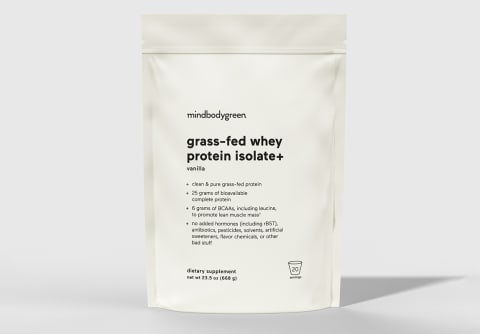Advertisement
5 Ways To "Feed" Your Muscles Daily To Support Longevity


Frailty is a major risk factor1 for falls and other health concerns—making it a key component of the longevity equation. As you can imagine, one of the best ways to prevent suboptimal muscle mass and bone density (and by proxy, help extend your life) is to focus on building and maintaining lean muscle mass through daily habits.
Still, it's not easy to spark muscle gains from scratch. Below, five beginner-friendly ways to "feed" your muscles daily for a longer and stronger life:
Strength training
Exercise in any form is a positive tick on the longevity checklist, but strength training comes with additional benefits including blood sugar balance, bone health, immunity function, and more.
Strength training can sound intimidating, but it doesn't have to be. Some of the best moves as recommended by trainers are super basic—think glute bridges, split squats, and pushups. The trick: Add weights or reps as you begin to build strength for a continuous challenge and increased payoff for muscle gains.
Find a high-quality protein powder
Next up: protein. In order to build and maintain muscle, your body needs protein—and your daily targets may be higher than you think. While it depends on factors like age, weight, and lifestyle, most active women could benefit from eating upward of 100 grams of protein a day.
"Low protein intake could result in loss of muscle, which could lead to a slower metabolism2 and less 'body armor,' celebrity trainer Don Saladino previously told mindbodygreen, with body armor being protection from falls that can happen later in life3. (More than one in four people over the age of 65 years fall each year!)
So, yes, protein is a priority. And protein powder can make reaching your daily goals much more doable. If you're on the hunt for a high-quality option, consider the mindbodygreen grass-fed whey protein isolate+. In one serving, you'll find 25 grams of protein with a delicious flavor but without the added sugars. (Check out the six-item ingredient list for proof.)
Each serving also contains an adequate amount of the amino acid leucine (2.5 grams) to kick-start the process of muscle protein synthesis or the production of new muscle.* Many other protein powders, particularly plant-based ones, don't hit this 2.5-gram threshold, leaving valuable muscle benefits on the table.
Make sleep a priority
One area you surely shouldn't neglect on your journey to muscle gains is sleep, and it's not just so you can have more energy for your workout.
In a recent clinical study published in BMC Public Health, negative changes in sleep quality and duration decreased muscle mass while increasing fat mass, proving sleep to be a key player in overall muscle health.
What's more, a good night's rest will set you up for your strength training workouts that lie ahead. Pushing your body to lift heavy weights when you skipped a few hours of rest surely won't lead to peak performance.
Here are 15 tips to elevate your sleep quality and feed your muscles by extension.
Stretch after your workout
It's no secret that stretching after a workout will help relieve soreness, but it can also widen your range of motion4. With a wider range of motion comes a wider range of executable exercises in the gym. Plus, it just feels great, so why not?
Take rest days
It may be tempting to overcommit when you first begin strength training, but skipping a rest day won't do your muscles any good. In fact, research has shown that training frequency (how often you go to the gym) impacts strength and muscle gains far less than training volume5 (how many repetitions and sets you complete).
In other words: Add strength training to your schedule (say, three or four days a week), but use your off days to allow for muscle recovery. You don't have to be totally inactive on those days, but lay off the heavy lifting. Opt for walking, stretching, yoga, or another low-impact form of movement. You can rest assured you won't be losing any gains while you're at it.
Here's a trainer's recommendation for how to structure your workout schedule for adequate rest.
The takeaway
Low muscle mass can have major health implications as you age, so creating a routine to build and maintain lean muscle mass now is a good idea. To feed your muscles, start by consuming adequate amounts of protein daily, strength training a few days a week, getting high-quality sleep, stretching after every workout, and taking rest as needed. Want another challenge? Add grip strength exercises to the list—here's why they're A+ for longevity.
